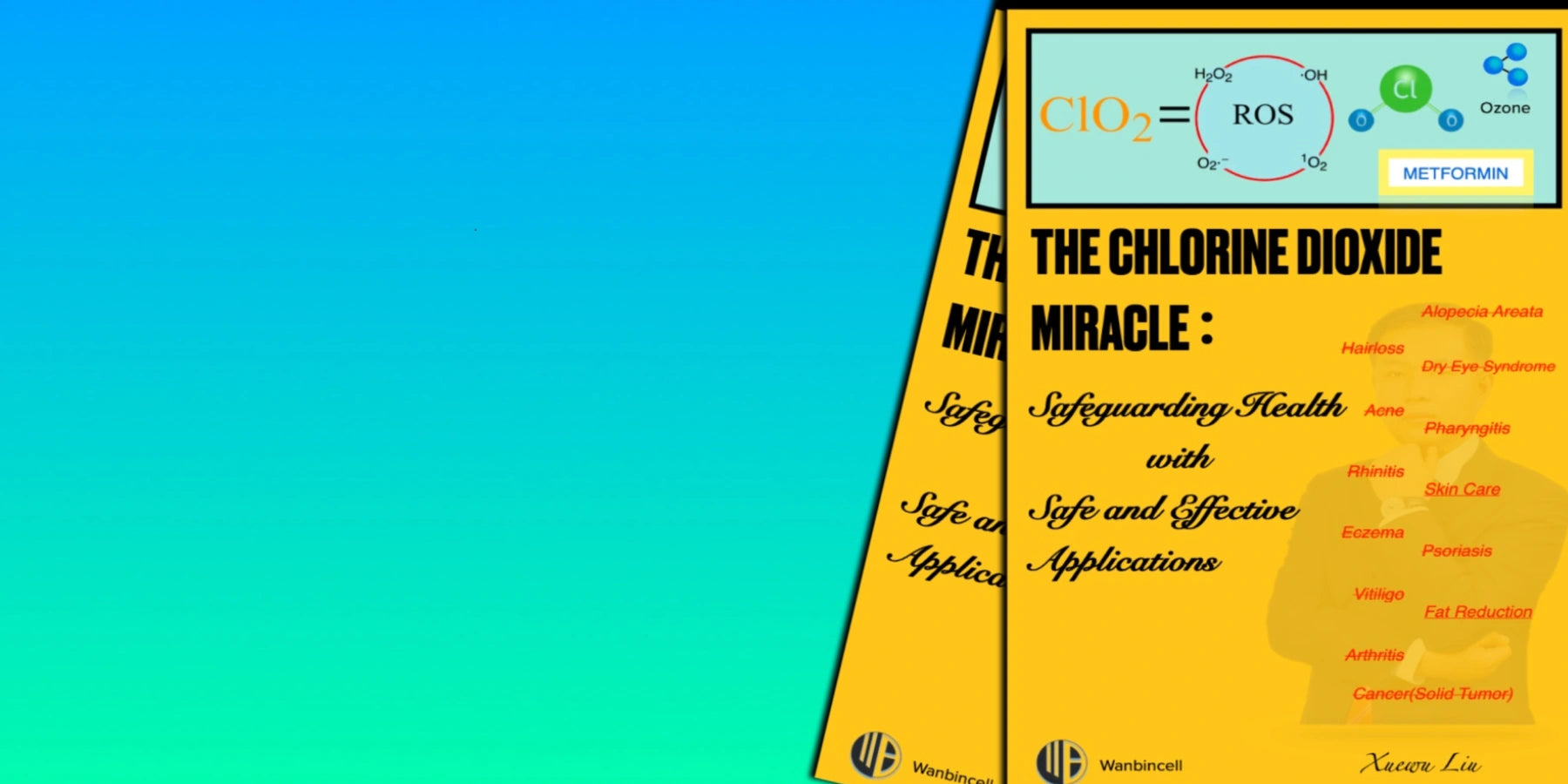
A Book About Chlorine Dioxide
Welcome! Explore the groundbreaking insights of this book. Discover the transformative potential of chlorine dioxide in health care, its mechanism of action in the body, and its ability to treat various diseases. Embark on a journey to a new understanding of health and healing.
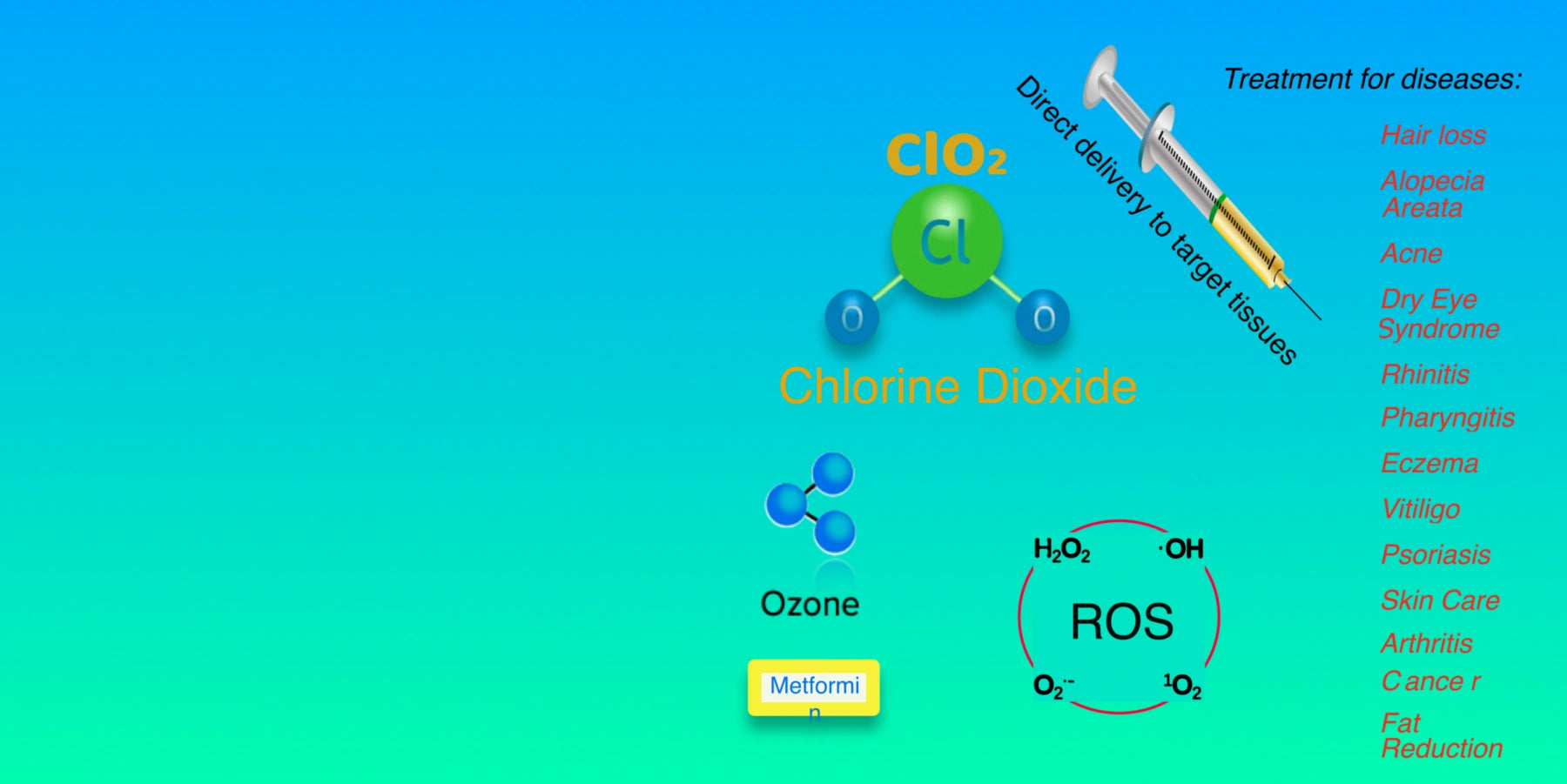
Intratumoral Delivery of Chlorine Dioxide Exploits its ROS-like Properties
A Novel Paradigm for Effective Cancer Therapy
Differences Between the Treatments in This Book and MMS and CDS
-
My Chlorine Dioxide Treatment
My chlorine dioxide treatment mainly involves directly delivering effective chlorine dioxide (at higher concentrations) to the affected area. This method can quickly treat various diseases, each with its own specific mechanism. All the treatments in this book are supported by necessary validation data.
-
MMS
MMS treatments primarily involve significantly diluting high-concentration chlorine dioxide and then ingesting it orally or via enema. This water solution containing chlorine dioxide is used to treat various diseases.
-
CDS
CDS, developed by Dr. h.c. Andreas Ludwig Kalcker as an improvement to MMS, primarily features a saturated chlorine dioxide solution (concentration around 0.3 mg/ml or 3000 ppm). The delivery methods mainly include diluted oral intake or intravenous injection. Occasionally, other delivery methods are used, but the chlorine dioxide concentration is often much lower than 3000 ppm.
The Magical Mechanism of Chlorine Dioxide
-
Eliminating Abnormal Cells
Learn MoreChlorine dioxide, a highly potent oxidizing agent, demonstrates remarkable efficacy in eliminating a diverse array of viruses and bacteria when present at specific concentrations. Its administration throughout the body results in the indiscriminate eradication of various cells, underscoring its potential for widespread cell elimination and therapeutic impact.
-
Promoting Tissue Regeneration
Learn MoreDrawing parallels to hydrogen peroxide, chlorine dioxide operates through a triad of mechanisms to promote tissue regeneration: combating infections, effectively cleansing adhesions near the wound site, and actively reducing inflammation. By engaging in these multifaceted actions, chlorine dioxide contributes significantly to the overall healing process and facilitates optimal tissue repair.
-
Regulating Immune Response
Learn MoreChlorine dioxide emulates the intricate signaling mechanisms of ROS within the body. This remarkable capability enables it to dynamically regulate immune responses, fostering a balanced immune system and promoting overall well-being. Furthermore, by effectively modulating immune function, chlorine dioxide aids in maintaining the body’s natural defense mechanisms, ensuring optimal health and vitality.
The Role of Chlorine Dioxide in the Body
Chlorine Dioxide, having similar properties to ROS, could theoretically have comparable benefits. It might positively impact the treatment of hair loss, autoimmune skin conditions like eczema and psoriasis, autoimmune diseases, disorders of tissue regeneration, age-related diseases, and cancer. My experimental data also supports chlorine dioxide’s therapeutic potential in these areas, showing it can encourage tissue regeneration, modulate immune responses, and assist in treating cancer and aging-related diseases. I suggest a treatment method involving direct application of chlorine dioxide to the diseased site, applicable to any affected body part.
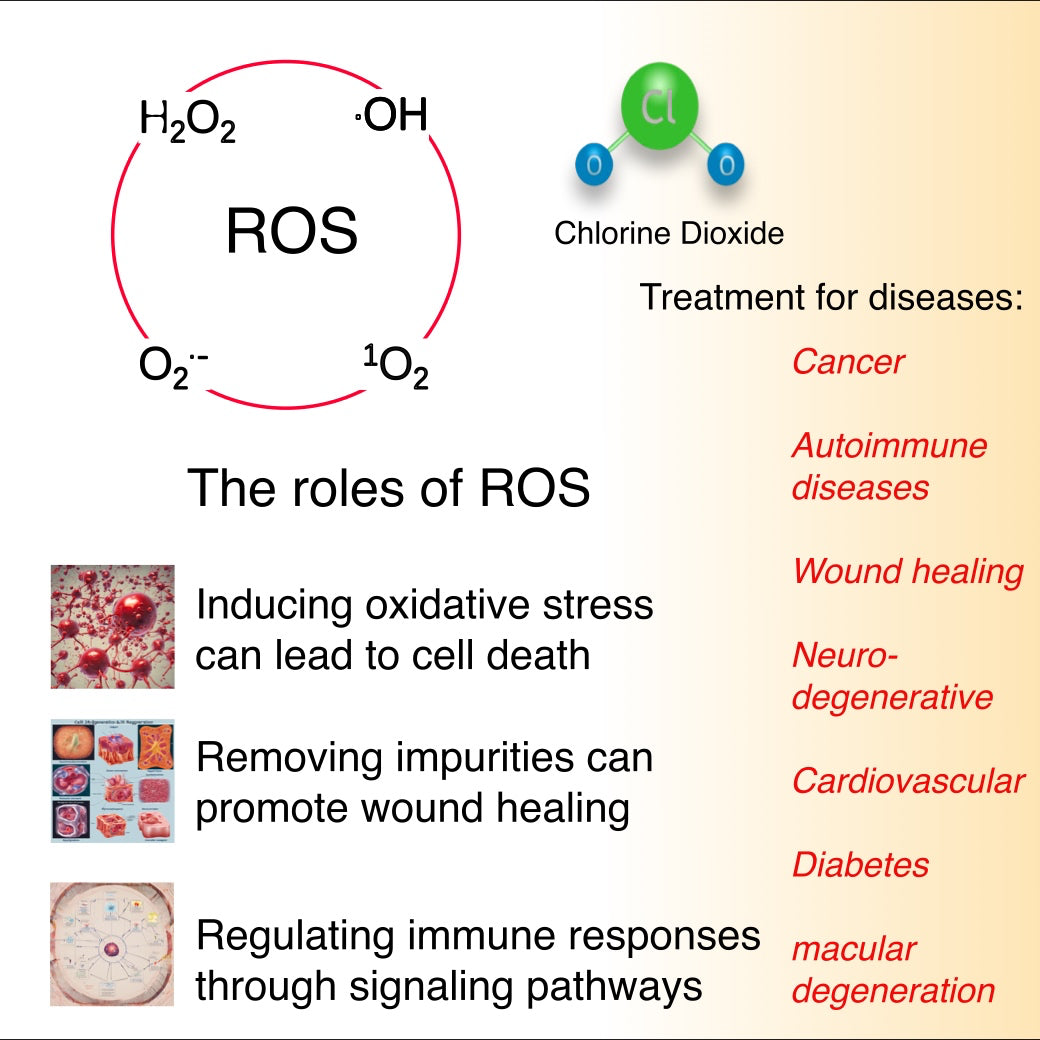
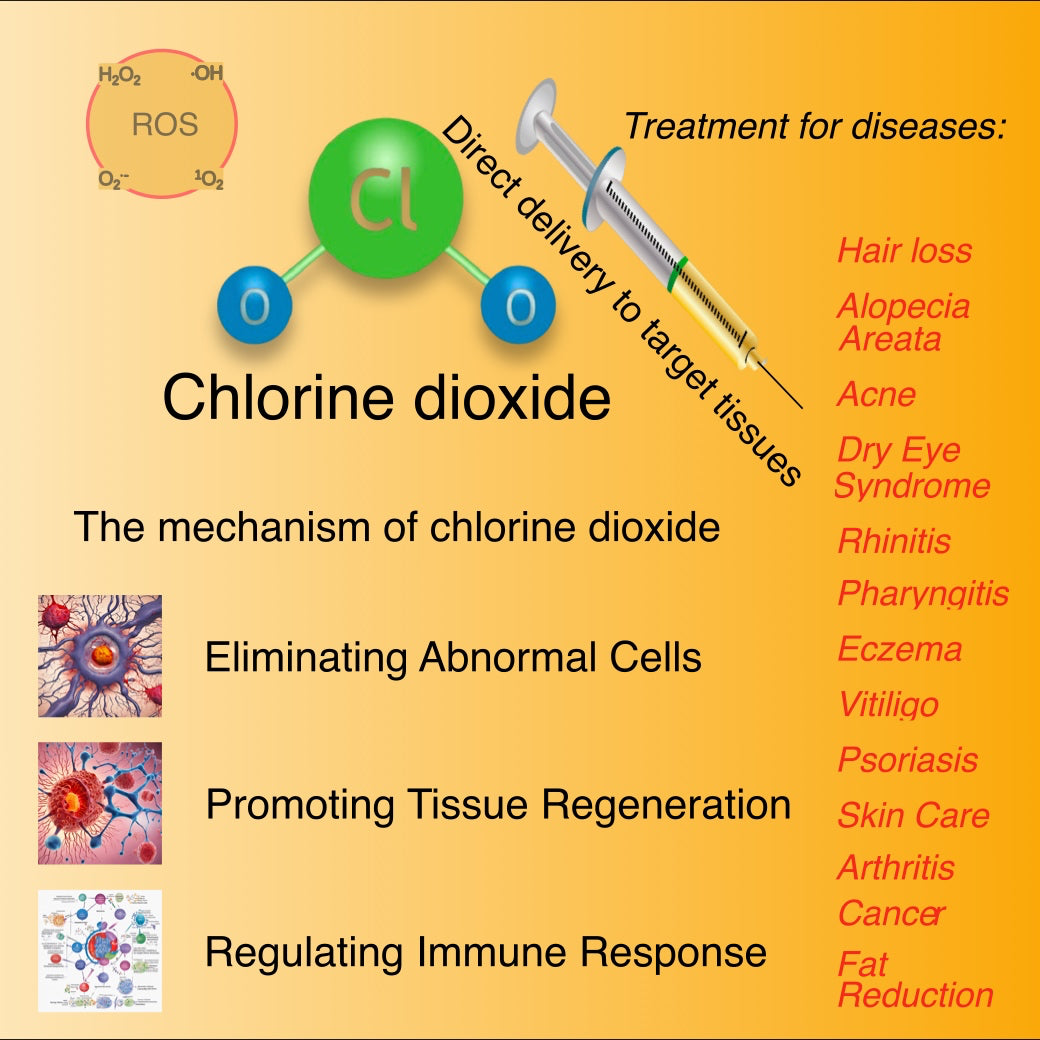
Chlorine Dioxide’s Effectiveness in Treating 13 Diseases Verified
Hair Loss
Eliminating Abnormal Cells+Promoting Tissue Regeneration
Chlorine dioxide treats hair loss by removing damaged cells and stimulating stem cell regeneration, promoting new hair growth with consistent, long-term use for best results.
Alopecia Areata
Eliminating Abnormal Cells+Regulating Immune Response+Promoting Tissue Regeneration
Chlorine dioxide treats alopecia areata by promoting follicle regeneration, reducing scalp inflammation, and blocking immune attacks on follicles, showing potential for autoimmune skin diseases.
Acne
Eliminating Abnormal Cells+ Promoting Tissue Regeneration +Regulating Immune Response
Chlorine dioxide treats acne by clearing damaged cells, fighting bacteria, and promoting tissue regeneration, thus avoiding damage from squeezing and effectively reducing scars.
Dry Eye Syndrome
Regulating Immune Response
Chlorine dioxide treats dry eye by stimulating tear secretion and suppressing inflammation, potentially restoring immune balance, with no recurrences after treatment.
Pharyngitis
Eliminating Abnormal Cells+Regulating Immune Response
Treatment for chronic pharyngitis includes addressing symptoms and causes, possibly using chlorine dioxide for its anti-inflammatory effects, based on personal success.
Eczema
Eliminating Abnormal Cells+Regulating Immune Response+Promoting Tissue Regeneration
Eczema, an autoimmune skin disease, is incurable but treatable for symptoms. Chlorine dioxide treatment for 15 days cured a patient’s widespread eczema.
Vitiligo
Eliminating Abnormal Cells+Regulating Immune Response
Chlorine dioxide treats vitiligo similarly to psoriasis by regulating the immune response, clearing misidentified antigens, modulating signaling pathways, and reducing immune hyperactivity, alleviating symptoms.
Psoriasis
Eliminating Abnormal Cells+Regulating Immune Response+Promoting Tissue Regeneration
Autoimmune disease treatment involves eliminating misidentified antigens and adjusting signaling pathways. Chlorine dioxide shows promise by potentially achieving these goals, offering hope for curing diseases like psoriasis, with successful cases under guidance.
Arthritis
Eliminating Abnormal Cells+ Promoting Tissue Regeneration + Regulating Immune Response
Autoimmune disease treatments focus on symptoms, not causes. Chlorine dioxide, by clearing damaged cells and modulating immune responses, shows promise in treating such diseases, including through self-experimentation for arthritis.
Rhinitis
Regulating Immune Response
Chronic rhinitis, often manageable with medication and lifestyle changes, significantly impacts daily life. Chlorine dioxide, with anti-inflammatory and immunomodulatory properties, shows promise in treatment by clearing allergens.
Skin Care
Eliminating Abnormal Cells+ Promoting Tissue Regeneration
Skincare involves removing aging cells and regenerating skin, with chlorine dioxide aiding both. Regular application enhances hydration, smoothness, even skin tone, and reduces acne scars.
Fat Reduction
Eliminating Abnormal Cells
Self-experimentation revealed chlorine dioxide effectively dissolves localized fat with direct injection into targeted areas, suggesting its use as a weight loss treatment and hinting at broader therapeutic potential.
Cancer
Our team exploreschlorine dioxide for cancer treatment, leveraging its ROS-like oxidizing properties to destroy cancer cells and aid tissue repair. We’ve found it safe for therapeutic use, focusing on direct tumor injections to kill cancer cells without causing drug resistance. Chlorine dioxide also stimulates an immune response, enhancing its therapeutic effects. Our aim is to make cancer a manageable condition, using chlorine dioxide’s unique properties to improve patient outcomes. This innovative approach could transform cancer treatment, with ongoing studies needed to refine delivery and dosage, and to investigate synergies with other treatments. Direct tumor injection of chlorine dioxide stands out as a promising cancer therapy strategy.
Theoretically, intratumoral injection of chlorine dioxide therapy can be used to treat various solid cancers, including lung cancer, breast cancer, colorectal cancer, prostate cancer, stomach cancer, liver cancer, ovarian cancer, endometrial cancer, bladder cancer, pancreatic cancer, kidney cancer, esophageal cancer, thyroid cancer, gallbladder cancer, bile duct cancer, gastrointestinal stromal tumor, osteosarcoma, neuroblastoma, nasopharyngeal cancer, melanoma, mesothelioma, thymoma, multiple myeloma, insulinoma, glioma, eyelid tumor, hepatocellular carcinoma, intrahepatic cholangiocarcinoma, gallbladder adenocarcinoma, cholangiocarcinoma, pancreatic neuroendocrine tumor, pancreatic cystic tumor, mucinous cystic neoplasm of the pancreas, serous cystadenoma of the pancreas, cystadenoma of the pancreas, solid pseudopapillary neoplasm of the pancreas, cystic adenoma of the pancreas, cystic neoplasm of the pancreas, solid and cystic neoplasm of the pancreas, pancreatic mucinous carcinoma, pancreatic serous carcinoma, pancreatic adenocarcinoma, pancreatic cystadenocarcinoma, pancreatic solid carcinoma, pancreatic islet cell carcinoma, pancreatic neuroendocrine carcinoma, pancreatic neuroendocrine tumor, pancreatic cystic carcinoma, pancreatic serous carcinoma, pancreatic solid carcinoma, pancreatic mucinous cystadenoma, pancreatic serous cystadenoma, pancreatic cystadenoma, pancreatic solid pseudopapillary neoplasm, pancreatic cystic adenoma, pancreatic cystic neoplasm, pancreatic mucinous carcinoma, pancreatic serous carcinoma, and pancreatic adenocarcinoma.
About
-

The Author
Learn MoreXuewu Liu has conducted extensive self-experiments to showcase the remarkable therapeutic effects of chlorine dioxide. Since 2012, he has been at the forefront of advocating for the safe and effective use of chlorine dioxide in treating various diseases, making him the first person in the world to systematically utilize chlorine dioxide for medical purposes. Drawing on his extensive research expertise and sophisticated scientific reasoning, Liu has uncovered and developed three significant physiological mechanisms of chlorine dioxide as well as multiple treatment protocols for a range of diseases.
-
MMS
Learn MoreJim Humble’s MMS Controversy: Unraveling the Chlorine Dioxide Treatment Debate and FDA Warnings.
-
Patents
Learn MoreExploring Chlorine Dioxide’s Medical Potential: From Cancer Treatment to Hair Growth Innovations.
-
ROS
Chlorine Dioxide and Reactive Oxygen Species (ROS): Balancing Health, Aging, and Disease Treatment.
-
Ozone
Harnessing Ozone and Chlorine Dioxide: Therapeutic Applications in Medicine.
Reader's Letter
-
I am still slowly reading your books and I want to thank you for being one of the very few people who talks about antioxidants to admit that they have made way too much of a fad in recent years, and an actually anti-health one to the extent that the health-sabotage “health care” establishment has been actually exploiting their asymmetry of knowledge gap that know perfectly well they have over the public in matters of health biochemistry by having people constantly squashing out so many of their vital biochemical processes that require the ability, however momentary, of breaking chemical bonds, which are made up of shared pairs of electrons between atoms, into single-electron radicals (from the Latin word “radix”), by feverishly gulping down anti-oxidants to supposedly keep healthy.
As you update this important book of yours I would urge you to show a picture of the ClO2 molecule itself, and not only explain that chemical bonds are really a yin-yang pair of single electrons, but that all essential chemistry requires at least momentarily breaking these pairs in order that atoms and molecular fragments may be moved around and new connections be formed. But if our systems are constantly flooded with radical-neutralizing antioxidants, this actually essential chemistry simply cannot happen.
Once again, thanks for listening. -
Hi blessings from Scotland. I've been intrigued for a year or two in taking MMS but something comes up and I forget.My fear is purchasing something that isn't pure which i definitely don't want to ingest into my body which will make me sick Can you please recommend one that you personally would purchase I am 66 years old and these past four years have definitely had an impact on my health.Im definitely not a person for going to the Dr and would rather treat ailments with natural remedies.Thanks
-
Hello Mr. Liu, A question please, have you ever had any experiencewith the above? For many years now the the only relief I get is by taking Predsisone. If you have any words you care to offer, it would be much appreciated, thank you.
P.S. I'm 79 years age.And, diagnosed as having an abnormal T cell clone.
-
Hello Liu Xuewu,
I actually hadn't thought of delivery through lipid nanoparticles! Genius idea. My idea was if Chlorine Dioxide can break down lipid nanoparticles (thus exposing their cargo - I am referring to the mRNA contained in the lipid nanoparticles of the mRNA vaccines). I have started reading your book - very excellent overview, and I love your method of modeling. I am intrigued that you could inject or directly deliver ClO2 directly... I am also wondering if it would be beneficial to my own autoimmune issues (Crohn's Disease). I've managed to go without any Pharma drugs for the longest while, but it is still there and have to deal with occasional issues. I really appreciate your quick response,Best Regards,
Buy the Book
Around ten years ago, the author applied for patents for the treatment protocols outlined in this book, which target a wide range of 13 diseases. However, the author has chosen to make these protocols available to the public for a nominal fee. This enables individuals to obtain and utilize these protocols for treating the specified diseases without incurring any extra costs.
myxcancer/Wanbincell
The Chlorine Dioxide Miracle: Safeguarding Health with Safe and Effective Applications -eBook
You will get the following files: PDF, EPUB and AZW3.| After payment is completed, the download link will be sent to the email address provided by the purchaser.
Share
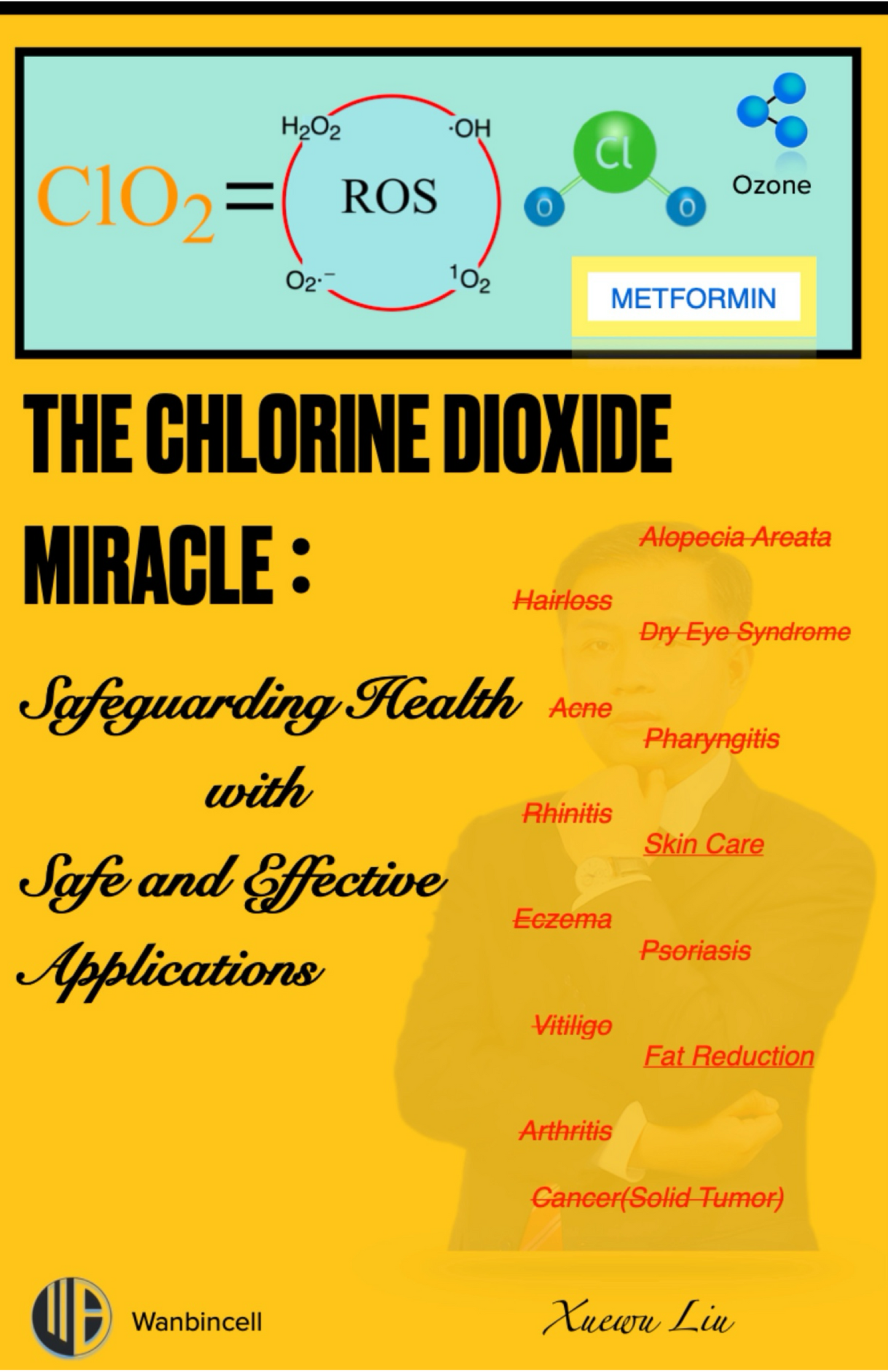
Purchase the Paperback Edition
MyXcancer
The Chlorine Dioxide Miracle: Safeguarding Health with Safe and Effective Applications-Paperback
Share
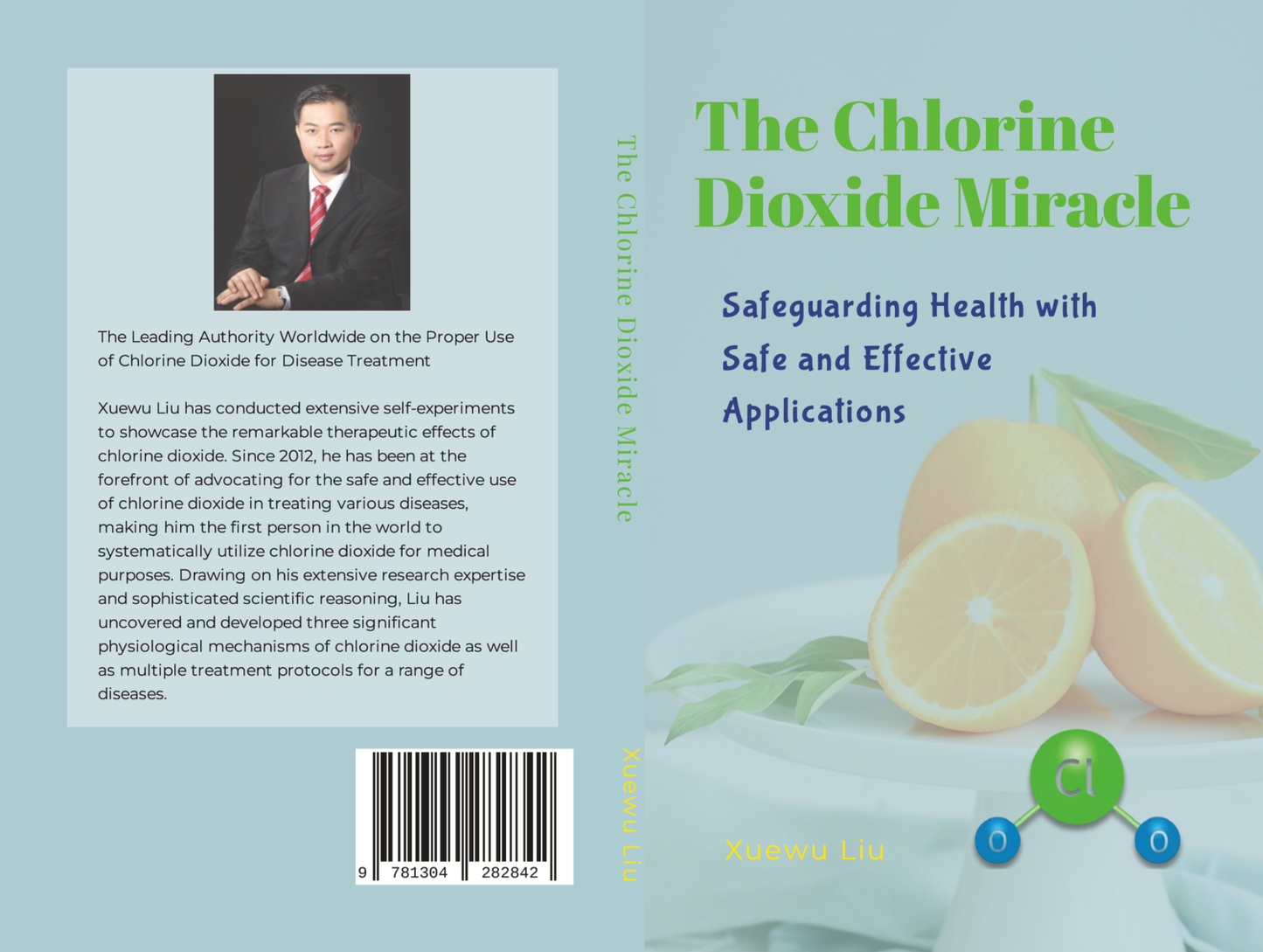
Preview the Book
CONTENTS
Contents 4
Preface 7
1. Understanding Chlorine Dioxide 9
1.1 The Properties of Chlorine Dioxide 9
1.2 The Medical History of Chlorine Dioxide 11
1.3 The Role of Chlorine Dioxide in the Body 14
2. The Model of Life: A Fresh Perspective on Understanding Disease 17
2.1 The Model of Life 17
2.2 Treatment or Prevention of Diseases 19
2.3 Toxic Excitatory Effect 21
2.4 The Life Model and Chlorine Dioxide 22
2.5 The Updated Disease Research Model 24
3. Free Radicals, Ozone, and Chlorine Dioxide 28
3.1 Free Radicals and Antioxidant Therapy 28
3.2 Exploring Chlorine Dioxide's Potential Through Ozone's Clinical Use 31
4. The Magical Mechanism of Chlorine Dioxide 34
4.1 The Non-Selective Cell Elimination Mechanism of Chlorine Dioxide 35
4.2 The Mechanism of Chlorine Dioxide in Promoting Tissue Regeneration 38
4.3 The Mechanism of Immune Response Regulation by Chlorine Dioxide 40
5. Treating Hair Loss with Chlorine Dioxide 43
5.1 The Cause of Androgenetic Alopecia 43
5.2 The Essence of Androgenetic Alopecia 45
5.3 The Difficulty of Treating Androgenetic Alopecia 45
5.4 The Mechanism of Using Chlorine Dioxide to Treat Hair Loss 46
5.5 Hair Loss Treatment Protocol 49
5.6 Frequently Asked Questions About Hair Loss Treatment 50
6. Treating Alopecia Areata with Chlorine Dioxide 54
6.1 Case Report of Using Chlorine Dioxide to Treat Alopecia Areata 55
6.2 The Mechanism of Using Chlorine Dioxide to Treat Alopecia Areata 57
6.3 Alopecia Areata Treatment Protocol 59
7. Treating Acne with Chlorine Dioxide 61
7.1 The Mechanism of Chlorine Dioxide in Treating Acne 61
7.2 Acne Treatment Protocol 62
8. Treating Dry Eye Syndrome with Chlorine Dioxide 64
8.1 Dry Eye Syndrome and Chlorine Dioxide 64
8.2 Dry Eye Syndrome Treatment Protocol 65
9. Treating Pharyngitis with Chlorine Dioxide 67
9.1 Pharyngitis and Chlorine Dioxide 67
9.2 Pharyngitis Treatment Protocol 68
10. Treating Eczema with Chlorine Dioxide 70
10.1 Eczema and Chlorine Dioxide 70
10.2 Eczema Treatment Protocol 71
11. Treating Psoriasis with Chlorine Dioxide 73
11.1 Psoriasis and Chlorine Dioxide 73
11.2 Psoriasis Treatment Protocol 76
12. Treating Vitiligo with Chlorine Dioxide 77
12.1 Treating Vitiligo with Chlorine Dioxide 77
12.2 Vitiligo Treatment Protocol 79
13. Using Chlorine Dioxide for Skin Care 81
13.1 Skin Care and Chlorine Dioxide 81
13.2 Skin Care Protocol 83
14. Treating Rhinitis with Chlorine Dioxide 85
14.1 Rhinitis and Chlorine Dioxide 85
14.2 Rhinitis Treatment Protocol 86
15. Treating Arthritis with Chlorine Dioxide 88
15.1 Treating Autoimmune Diseases and Arthritis 88
15.2 The Principle of Using Chlorine Dioxide to Treat Autoimmune Diseases 90
15.3 Arthritis Treatment Protocol 92
16. Treating Cancer with Chlorine Dioxide 95
16.1 A Deeper Understanding of Cancer Treatment 95
16.2 Research on Chlorine Dioxide Treatment for Cancer 99
16.3 Cancer Treatment Protocol 105
17. Using Chlorine Dioxide for Localized Fat Reduction 108
17.1 Chlorine Dioxide and Fat Reduction 108
17.2 Fat Reduction Protocol 110
18. Summary of Chlorine Dioxide Treatment Protocol 112
18.1 Hair Loss Treatment Protocol 114
18.2 Alopecia Areata Treatment Protocol 115
18.3 Acne Treatment Protocol 117
18.4 Dry Eye Syndrome Treatment Protocol 118
18.5 Pharyngitis Treatment Protocol 119
18.6 Eczema Treatment Protocol 121
18.7 Psoriasis Treatment Protocol 122
18.8 Vitiligo Treatment Protocol 123
18.9 Skin Care Protocol 124
18.10 Rhinitis Treatment Protocol 126
18.11 Arthritis Treatment Protocol 128
18.12 Cancer Treatment Protocol 130
18.13 Fat Reduction Protocol 132
The Author 134
PREFACE
In the spring of 2010, I embarked on a mission to find a cure for a friend suffering from bladder cancer. During my research, I came across the writings of Mr. Jim Humble on chlorine dioxide, also known as MMS. His accounts and case studies intrigued me and inspired me to explore the healing potential of this substance.
Approaching my experiments with caution, I followed Mr. Humble's guidance. However, I soon realized that our understanding of MMS and chlorine dioxide was limited. The mechanisms of action and safe application of this substance remained largely unknown. The available information was complex, contradictory, and often misleading, making the correct usage of chlorine dioxide a daunting task.
This realization prompted me to embark on a decade-long journey of intensive research. I delved into scientific literature and conducted numerous experiments to uncover the true therapeutic potential of chlorine dioxide from chemical, biological, and medical perspectives. My laboratory became a hub of innovation, where I tested various formulations and methods, leading to the discovery of new ways to effectively combat different diseases.
Throughout this process, I transitioned from a learner and experimenter to an innovator. I filed several patents related to medical use of chlorine dioxide and authored papers, some of which have been published, while others are currently undergoing the submission process. These achievements not only enhanced the credibility of my research but also established me as a recognized expert in the global community of utilizing chlorine dioxide for disease treatment.
It is important to note that my intention is not to refute Mr. Humble's MMS protocol, but rather to present an updated perspective on the evolution of MMS. I want readers to understand that this book aims to provide a comprehensive understanding of chlorine dioxide and its applications, ensuring that more people can benefit from this treatment method in a safe and informed manner.
Throughout my journey, I have been driven by a deep commitment and unwavering belief in the remarkable possibilities of chlorine dioxide. My ultimate goal is to spread awareness and understanding of this technology so that more people can experience its benefits and enhance their overall health and well-being. This book serves as a platform to educate and empower individuals to embrace the potential of chlorine dioxide for their own wellness journey. Together, we can unlock the transformative power of this technology and pave the way for a healthier future.
1. UNDERSTANDING CHLORINE DIOXIDE
1.1 THE PROPERTIES OF CHLORINE DIOXIDE
Chlorine dioxide is a compound with unique physical and chemical properties. It appears as a yellow-green gas at room temperature and has a pungent odor similar to that of chlorine. Here are some of its physical characteristics:
Molecular formula: ClO2
Melting point: -59 °C (-74 °F)
Boiling point: 11 °C (52 °F)
Density: Approximately 2.4 kg/m³ (in gaseous state at 0 °C and 101.3 kPa)
Solubility: In water, 3.01 g/L at 25 °C and 34.5 mm Hg.
Chemically, chlorine dioxide is an efficient electron acceptor, allowing it to react with a wide range of organic and inorganic substances. The redox potential of chlorine dioxide in acidic solutions is about +0.95 V, which is less than that of hydrogen peroxide (+1.776 V) and ozone (+2.07 V) under similar conditions. This indicates that chlorine dioxide’s oxidizing power is weaker than that of hydrogen peroxide and ozone. The strong oxidizing nature of chlorine dioxide is due to its ability to accept five electrons during redox reactions, as it transitions from a +4 to a -1 oxidation state in chlorine, which is more than most oxidants. Due to its potent oxidizing properties, it can effectively destroy bacteria, viruses, and certain types of parasites, making it particularly useful for disinfection and bleaching.
In industrial applications, chlorine dioxide is primarily used in the following areas:
Pulp Bleaching: In the paper industry, chlorine dioxide is used to bleach wood pulp to produce high-quality white paper. Compared to chlorine bleaching, chlorine dioxide reduces the formation of harmful chlorinated compounds.
Water Treatment: Chlorine dioxide is commonly used in drinking water and wastewater treatment because it can disinfect water without forming harmful by-products. It is particularly effective at eliminating odors and tastes in water.
Industrial Cleaning: Due to its strong oxidizing nature, chlorine dioxide is also used in some industrial and commercial cleaning processes, especially in environments that require disinfection, such as food processing plants and medical facilities.
The medical use of chlorine dioxide is currently mainly limited to topical applications, utilizing its disinfectant properties. Some clinical trials in Japan have applied chlorine dioxide to mucous membranes such as the mouth, again exploiting its disinfectant and germicidal effects.
Chlorine dioxide is a broad-spectrum, efficient, and safe sterilant. Multiple studies have shown that chlorine dioxide can kill various pathogens such as E. coli and Staphylococcus aureus at extremely low concentrations (0.1 ppm). Even in the presence of organic matter, concentrations of several tens of ppm can completely eliminate all microbes, including bacterial vegetative cells, hepatitis viruses, bacteriophages, and bacterial spores. During disinfection, chlorine dioxide undergoes redox reactions without chlorination reactions, unlike other chlorinated disinfectants (such as sodium hypochlorite, trichloroisocyanuric acid, sodium dichloroisocyanurate, etc.), so it doesn’t produce carcinogenic substances like chloroform, which are harmful to both the environment and human health.



